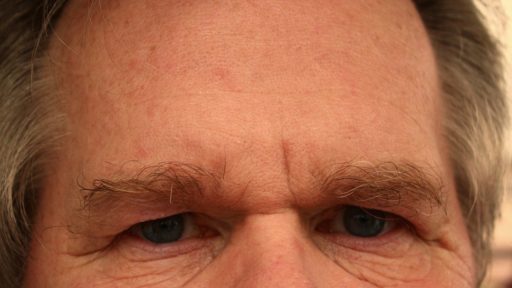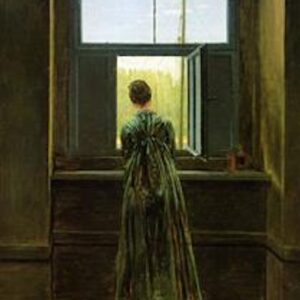I’ve never really understood why Georg Trakl talks about foreheads so much. I mean, you can imagine the word coming up once in a poem for some reason or other. I can even see that there is something fascinating about foreheads in that they are both of and not of the face. That’s to say, you don’t generally get a face without a forehead. The forehead sets up the face. And yet, it’s not really part of the face per se. The forehead is claimed to some degree by the rest of the head. It is a glimpse of the skull. It is a stoic and mostly featureless reminder that behind the bones of the head are the squishy parts of the brain. So, yes, I acknowledge that foreheads are, perhaps, more intriguing than at first they may seem.
But Georg Trakl mentions foreheads a lot in his poems. Dozens of times. I don’t have the exact number ready to hand. Let’s just accept that Trakl’s poetry is filled with foreheads and that there is no obvious rhyme or reason according to which all these foreheads appear.
Trakl, I should mention, was an Austrian poet of the late nineteenth and early twentieth centuries. He amazed and baffled his contemporaries. He was an intense and otherworldly sort of fellow. He wrote poems that were beloved, though admittedly not often understood, by people like Wittgenstein and Rilke and Heidegger. He was heavily addicted to drugs and alcohol and died of overdose aged twenty-seven, just at the start of World War I.
And pound for pound, I’d say that Georg Trakl used the word forehead more than any other poet in the history of poetry. I’m not sure how to prove that. But I’m quite confident it is true. The German word for forehead is, by the way, Stirne, die Stirne (this is the veraltet, the now outdated form of the word that Trakl generally preferred). It’s a more attractive word, in look and sound, I’d say, than the English word forehead or the other word with which Stirne is probably most often translated, which is brow and which I don’t particularly like as a word either, though I think we can all agree it’s a lot better than forehead.
Anyway, Trakl throws the word Stirne into his poetry frequently and without much in the way of justification. It is similar to the way he will call anything blue. He’ll call a moment blue or a time of day, generally the evening. He calls souls blue as well as organs. He talks of blueness itself, the existence of blue without anything in particular that is specifically blue. Trakl just liked to describe things, or better yet to characterize them, as being blue and he liked to throw the word Stirne into a poem sometimes, it seems, just for the sheer sake of doing so. Take the line “Und Schnee und Aussatz von seiner Stirne sinken,” which translates roughly as “and snow and leprosy sink from his forehead.” That line is from the poem Helian.
I chose that poem in particular because right after that line comes a line about stars. “An den Wänden sind die Sterne erloschen,” or “on the walls, the stars have expired.” You’ll notice, perhaps, that the word for forehead, Stirne, and the word for stars, Sterne (der Stern in the singular, die Sterne in the plural), bear a striking resemblance. Helian is not the only poem where this coupling of foreheads and stars happens. In quite a few poems by Georg Trakl, when you come across a Stirne you will soon also stumble upon some Sterne.
Take, for instance, this stanza from the famous poem, Sebastian in a Dream:
Rosige Osterglocke im Grabgewölbe der Nacht
Und die Silberstimmen der Sterne,
Daß in Schauern ein dunkler Wahnsinn von der Stirne des Schläfers sank
Rosy Lent lilies in the catacomb of night
And the silvery voices of stars,
That, with a shudder, sank a dark madness from the forehead of the sleeper
Here we go with foreheads and stars again. Perhaps the thing most to acknowledge here is that for a poet like Trakl words really and truly are things. Words have their own realities and their own ways. They aren’t tools. They aren’t a medium. They exist really and truly just like anything else. A vast cosmos of things that exist in relation to other things that exist. Language no less real than rocks or trees. The word Stirne is fascinating to Trakl just because of the way it looks and sounds. And then it is even more intriguing because of the fact that it evokes the word for stars. We get to leap from foreheads to stars. Literally, physically, viscerally the words touch one another.
The non-mystical thinker is inclined to find this coincidence less than earthshaking. But to a poet like Trakl the very fact that Stirne leads us to Sterne, this reality of the physical shape and sound of words, is therefore packed with truths, resonances, possibilities. The language itself simply is the reality. Stirne is linked to Sterne. And so foreheads are also linked to stars. The entire realm of created things suddenly leaps into a shimmer of correspondences. And also fades. These linkages are always also fading in the poetry of Georg Trakl. The crackling world of connections that allow us to leap from foreheads to stars in less than an instant is also a world of loss, a world in which the things that flare up do so only for an instant and then sink down again into the Adamah, the earth, the darkness, and always unto death. It is always the season of autumn in the poetry of Trakl. The light is ever the light of twilight and the shining of the sun only ever arrives in the reflection of the moon.
A few more lines of poetry (from Elis [third version]):
Zeichen und Sterne
Versinken leise im Abendweiher.
Hinter dem Hügel ist es Winter geworden.
Blaue Tauben
Trinken nachts den eisigen Schweiß,
Der von Elis’ kristallener Stirne rinnt.
Immer tönt
An schwarzen Mauern Gottes einsamer Wind.
Signs and stars
sink silently in the evening pond
Winter has come behind the hill
Blue doves
Drink at night the icy sweat,
Which runs from Elis’s crystalline forehead
Always it rings
On blackened walls, the lonely wind of God.
Morgan Meis has a PhD in Philosophy and is a founding member of Flux Factory, an arts collective in New York. He has written for n+1, The Believer, Harper’s Magazine, The Virginia Quarterly Review and is a contributor at The New Yorker. He won the Whiting Award for non-fiction in 2013. Morgan is also an editor at 3 Quarks Daily, and a winner of a Creative Capital | Warhol Foundation Arts Writers grant. A book of Morgan’s selected essays can be found here. His new book from Slant is The Drunken Silenus. He can be reached at morganmeis@gmail.com.





